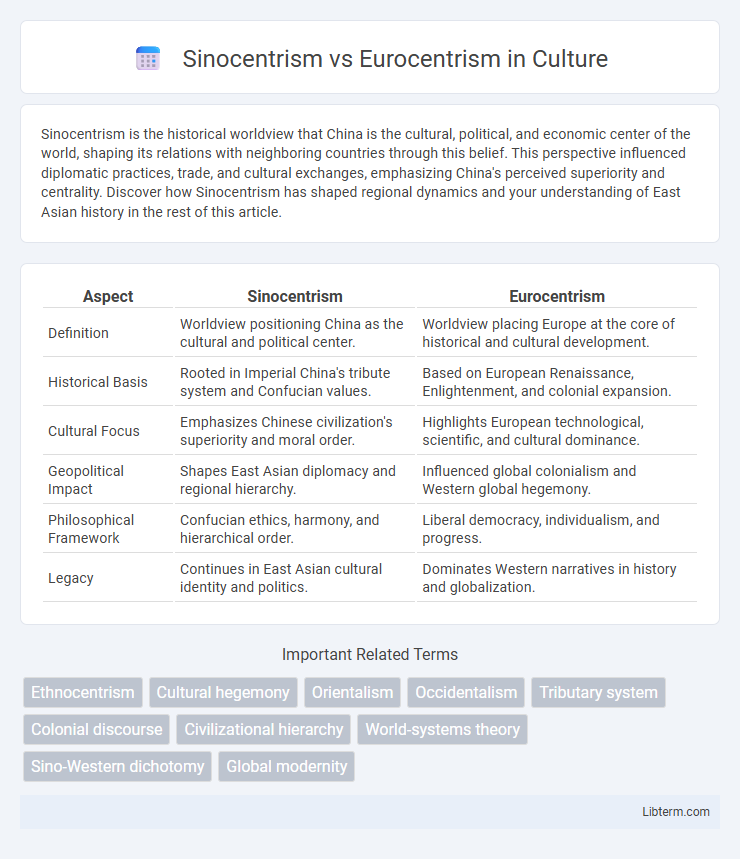Sinocentrism is the historical worldview that China is the cultural, political, and economic center of the world, shaping its relations with neighboring countries through this belief. This perspective influenced diplomatic practices, trade, and cultural exchanges, emphasizing China's perceived superiority and centrality. Discover how Sinocentrism has shaped regional dynamics and your understanding of East Asian history in the rest of this article.
Table of Comparison
| Aspect | Sinocentrism | Eurocentrism |
|---|---|---|
| Definition | Worldview positioning China as the cultural and political center. | Worldview placing Europe at the core of historical and cultural development. |
| Historical Basis | Rooted in Imperial China's tribute system and Confucian values. | Based on European Renaissance, Enlightenment, and colonial expansion. |
| Cultural Focus | Emphasizes Chinese civilization's superiority and moral order. | Highlights European technological, scientific, and cultural dominance. |
| Geopolitical Impact | Shapes East Asian diplomacy and regional hierarchy. | Influenced global colonialism and Western global hegemony. |
| Philosophical Framework | Confucian ethics, harmony, and hierarchical order. | Liberal democracy, individualism, and progress. |
| Legacy | Continues in East Asian cultural identity and politics. | Dominates Western narratives in history and globalization. |
Introduction to Sinocentrism and Eurocentrism
Sinocentrism centers on the historical worldview that China is the cultural, political, and economic axis of the world, shaping East Asian diplomacy and trade for centuries. Eurocentrism positions Europe as the origin and pinnacle of global civilization, influencing Western colonialism, science, and cultural narratives. Both frameworks reflect ethnocentric perspectives driving regional dominance and identity construction during different historical periods.
Historical Origins of Sinocentrism
Sinocentrism originated during the early Zhou dynasty when China viewed itself as the "Middle Kingdom," central to the civilized world. The tributary system established under the Han and Tang dynasties reinforced this worldview, positioning surrounding states as peripheral and culturally inferior. This ancient ideological framework contrasts with Eurocentrism, which emerged later through European colonial expansion and the Enlightenment's emphasis on Western norms.
Historical Roots of Eurocentrism
Eurocentrism originated during the Age of Exploration in the 15th and 16th centuries, driven by European imperial expansion and the subsequent colonization of Africa, Asia, and the Americas. This worldview positioned Europe as the pinnacle of civilization, progress, and cultural superiority, framing other societies as exotic, primitive, or inferior. Eurocentric historical narratives often marginalized non-European contributions, reinforcing power structures that justified colonial dominance and cultural assimilation.
Core Ideologies and Worldviews Compared
Sinocentrism centers on the belief that China is the cultural and political hub of the world, emphasizing harmony, hierarchical relationships, and Confucian values as the foundation of global order, while Eurocentrism prioritizes Western civilization's scientific progress, individualism, and democratic ideals as universal standards. Sinocentric ideology promotes a worldview where other nations are seen through the lens of tributary relations and cultural assimilation, contrasting with Eurocentrism's emphasis on nation-states, colonization, and the spread of Western norms. These core differences reflect divergent interpretations of power, civilization, and legitimacy shaping global interactions and historical narratives.
Influence on Global Politics and Diplomacy
Sinocentrism shaped global politics by promoting China's cultural superiority and hierarchical tribute system, influencing East Asian diplomatic relations and regional stability. Eurocentrism drove colonial expansion and the establishment of international law based on European norms, profoundly impacting global governance and power dynamics. Both frameworks affected diplomatic strategies, with Sinocentrism emphasizing harmony and hierarchy, while Eurocentrism prioritized sovereignty and legal equality among states.
Impact on Cultural Narratives and Education
Sinocentrism shapes cultural narratives by emphasizing Chinese history, values, and Confucian ideals as central to regional identity, influencing educational curricula across East Asia that prioritize Chinese classics and worldview. Eurocentrism dominates global education systems by promoting European history, philosophy, and scientific achievements as universal benchmarks, often marginalizing non-European perspectives. Both frameworks impact cultural self-perception and intercultural understanding, shaping knowledge production and access within their respective spheres.
Modern Manifestations in International Relations
Sinocentrism in modern international relations emphasizes China's historical cultural centrality and advocates for a multipolar world order with Asia as a pivotal hub, reflecting the Belt and Road Initiative's expansion and Confucian diplomatic rhetoric. Eurocentrism persists through Western dominance in global institutions like the United Nations and IMF, shaping international norms, human rights discourse, and economic policies according to Western historical experiences. The tension between these paradigms influences global governance structures, strategic alliances, and the framing of global challenges such as trade regulations and security architectures.
Criticisms and Controversies of Both Worldviews
Sinocentrism faces criticism for promoting cultural superiority and minimizing the contributions of other Asian civilizations, often reinforcing nationalistic agendas in East Asia. Eurocentrism is widely contested for its historical role in justifying colonialism, perpetuating racial hierarchies, and marginalizing non-Western perspectives in global history and knowledge production. Both worldviews are challenged for fostering exclusionary narratives that distort global cultural diversity and impede cross-cultural understanding.
Beyond Dichotomies: Toward Inclusive Perspectives
Sinocentrism and Eurocentrism represent exclusive worldviews centered on Chinese and European cultural and historical dominance, respectively, often marginalizing other civilizations. Moving beyond these dichotomies requires embracing inclusive perspectives that recognize the plurality of global narratives and interconnected influences shaping human history. This approach fosters cross-cultural understanding by integrating diverse epistemologies, promoting equitable representation in knowledge production, and challenging hegemonic paradigms.
Conclusion: Lessons from Sinocentric and Eurocentric Thought
Sinocentrism emphasizes harmony, hierarchy, and moral governance as central pillars of civilization, while Eurocentrism prioritizes individualism, scientific progress, and rationality. Both worldviews reveal how cultural biases shape historical narratives and global interactions, underscoring the importance of pluralistic perspectives in understanding world history. Recognizing the strengths and limitations of Sinocentric and Eurocentric thought fosters a more balanced and inclusive approach to intercultural dialogue and global development.
Sinocentrism Infographic

 libterm.com
libterm.com